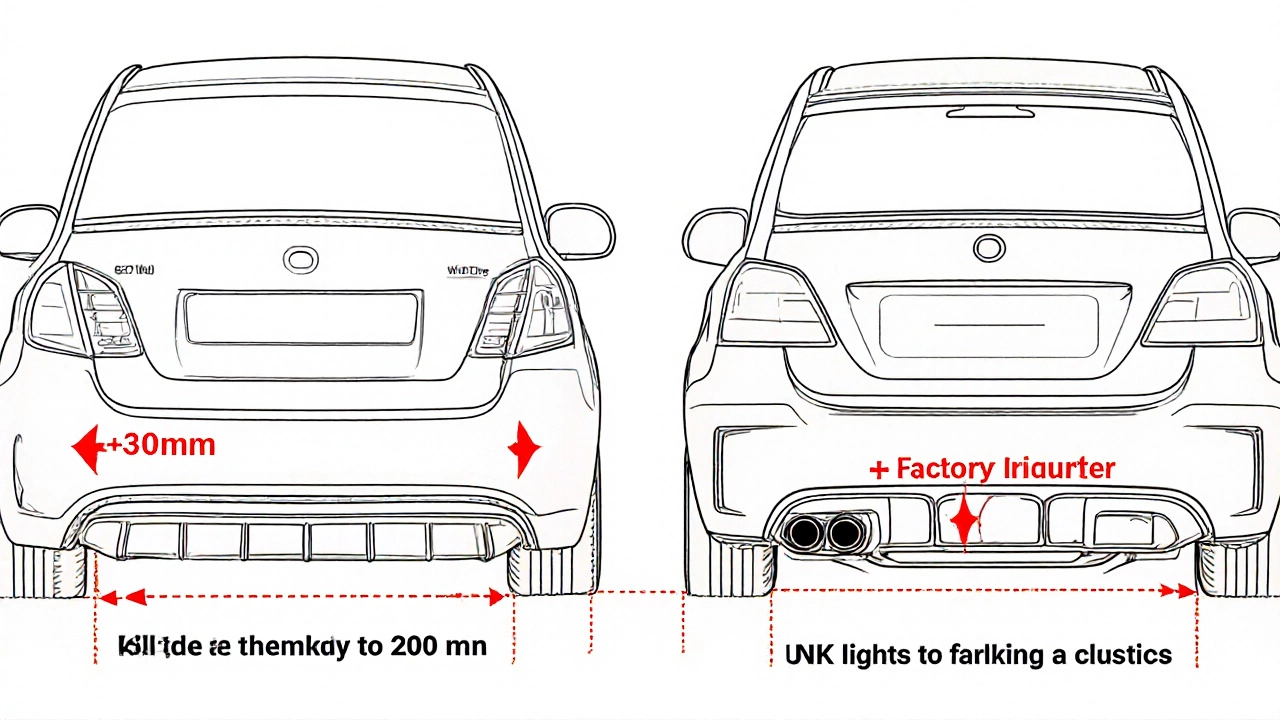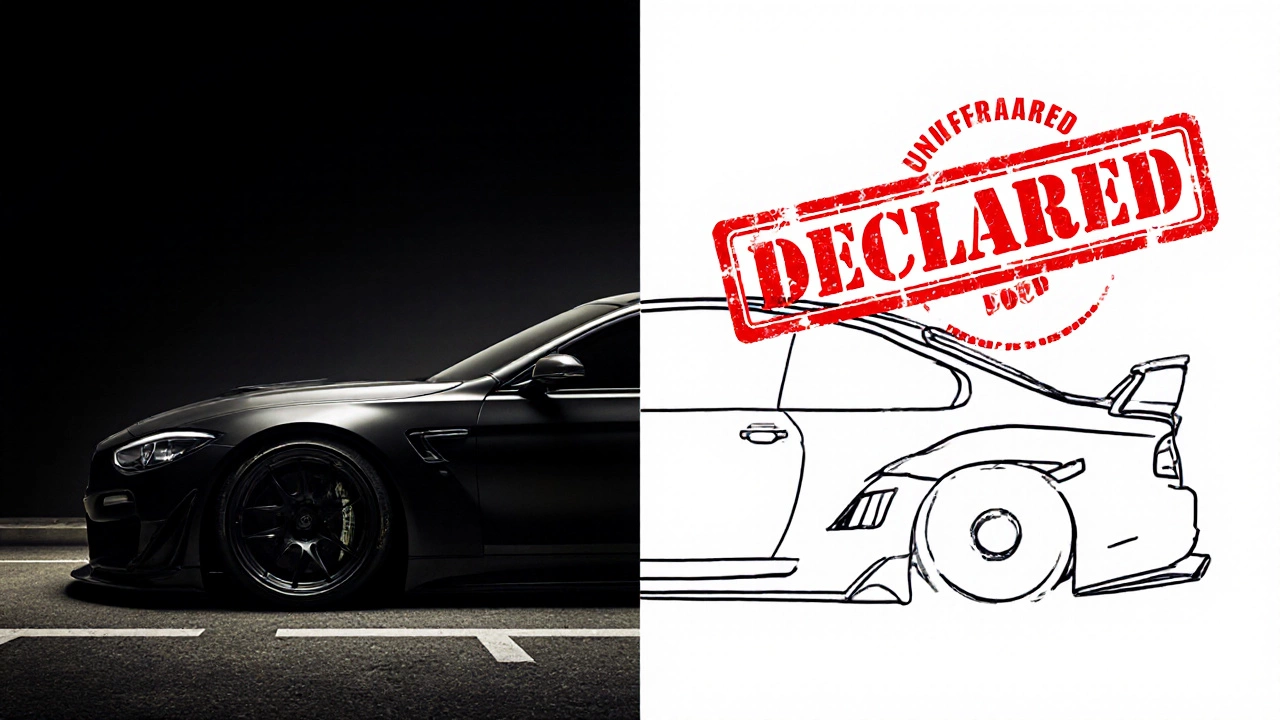Body Kit Compliance Calculator
Check Your Body Kit Compliance
Enter your vehicle's original and modified dimensions to determine if declaration is required in your location.
Changing your car’s look with a body kit isn’t just about style-it’s about legality. If you slap on a widebody kit, rear diffuser, or front lip without checking the rules, you could be driving an illegal vehicle. No one wants a ticket, a failed inspection, or to be forced to remove their favorite mod. So, do you need to declare a body kit? The answer isn’t simple. It depends on where you live, what kind of kit you installed, and how it changes your car’s original specs.
What Counts as a Body Kit?
A body kit isn’t just one part. It’s a set of aftermarket panels that replace or add to your car’s factory bodywork. Common pieces include front bumpers, side skirts, rear bumpers, fender flares, and spoilers. Some kits are purely cosmetic-just plastic trim that doesn’t change the car’s dimensions. Others are full widebodies that widen the wheel arches, alter aerodynamics, or change the vehicle’s height.
The key question isn’t whether you installed it. It’s whether the kit changes the car’s original certified dimensions or safety features. If your new front bumper sticks out 3 inches beyond the original, that’s a problem in most places. If your side skirts drag on the road or block headlights, that’s a safety issue. Even if it looks cool, if it violates engineering standards, you’re breaking the law.
Why Declaration Matters
When you buy a new car, it comes with a certificate of conformity. That document says the vehicle meets safety, emissions, and structural standards set by your country’s transportation authority. Installing a body kit can invalidate that certificate.
Most countries require you to declare modifications that affect:
- Vehicle width or height
- Weight distribution
- Visibility (e.g., blocked mirrors or lights)
- Structural integrity (e.g., cutting frame rails)
- Aerodynamic behavior (e.g., large rear wings)
Failure to declare means your car no longer matches its registered specs. That’s why police can pull you over for an unapproved body kit-even if it doesn’t seem dangerous. Inspectors compare your car to the official records. If the numbers don’t match, you’re in violation.
Where You Live Changes Everything
There’s no global rule. Laws vary wildly between countries-and even between states or provinces.
In the United States, each state sets its own rules. California is strict. Any modification must be approved by the California Air Resources Board (CARB) and the Department of Motor Vehicles (DMV). A body kit that alters the car’s width or height requires a modified vehicle inspection. In Texas, it’s looser-unless the kit obstructs lights or creates a hazard, you might not need paperwork. But if you get pulled over and the officer says it’s unsafe, you’ll still have to fix it.
In the European Union, all modifications must follow UNECE Regulation 78 or 95. You need an Individual Vehicle Approval (IVA) or a Certificate of Conformity (CoC) update. If your kit changes the car’s width by more than 20mm, you must notify your national transport authority. Germany’s TÜV is especially strict-your car must pass a full technical inspection before you can legally drive it.
In Australia, each state has its own road authority. In New South Wales, any body kit that alters the vehicle’s outline requires certification from a licensed vehicle modifier. In Victoria, you need a Certificate of Compliance from an approved inspector. Skip this, and you can’t renew registration.
Canada, Japan, and the UK have similar systems. The pattern is clear: if it changes how your car looks from the outside, officials want to know.

What Happens If You Don’t Declare It?
Ignoring the rules doesn’t mean you’ll get caught every time. But when you do, the consequences are serious:
- Failed inspection: Your car won’t pass mandatory safety checks. No pass = no registration renewal.
- Fines: In the EU, fines can be €500-€2,000. In California, it’s $250-$1,000 per violation.
- Impoundment: If an officer deems your car unsafe, they can tow it until you fix the issue.
- Insurance voidance: If you crash and your body kit wasn’t declared, your insurer can deny your claim. That’s not a rumor-courts have upheld this in multiple cases.
- Resale problems: Buyers and dealers will refuse to touch a car with undocumented mods. You’ll lose value fast.
One owner in Florida installed a widebody kit and didn’t register it. Two years later, he sold the car. The buyer found out during inspection. The deal collapsed. The seller had to pay $3,200 to remove the kit and restore the original bodywork.
How to Declare a Body Kit (Step-by-Step)
Declaring a body kit isn’t rocket science. Here’s how to do it right:
- Check your local laws: Visit your state/province’s motor vehicle website. Search for “vehicle modification regulations” or “aftermarket parts.”
- Document everything: Take photos of your car before and after. Keep receipts for the kit and installation. Note exact dimensions-width, height, overhang.
- Find an approved inspector: Many places require a certified vehicle modifier or inspection station to sign off on the changes. Ask your local DMV or transport authority for a list.
- Submit paperwork: Fill out the modification declaration form. Attach photos, receipts, and the inspector’s certificate.
- Update your registration: Once approved, your vehicle record will be updated. Keep the approval letter with your title.
Some kits come with a certificate of compliance from the manufacturer. If yours does, that speeds things up. But even then, you still need official approval from your government agency.

What Body Kits Are Usually Legal Without Declaration?
Not all changes need paperwork. You’re generally safe if:
- The kit is purely decorative and doesn’t extend beyond the original body lines.
- It doesn’t alter the height, width, or weight distribution by more than 10mm.
- All lights, mirrors, and sensors remain fully functional and unobstructed.
- No cutting, welding, or structural changes were made to the chassis.
For example, a carbon-fiber lip spoiler that clips onto the existing bumper without altering its shape? Usually fine. A full rear diffuser that extends 6 inches below the original bumper? That’s a problem.
When in doubt, measure. Compare your modified car’s width to the factory specs in the owner’s manual. If it’s wider, taller, or longer, declare it.
Pro Tips to Avoid Trouble
- Buy kits labeled “street legal” or “ECE approved.” These are designed to meet regulations-but you still need to declare them.
- Don’t trust installers who say “no one cares.” They’re not liable if you get fined.
- Keep your approval documents in your glovebox. You might need to show them during a traffic stop or inspection.
- If you’re planning to sell the car later, leave the original parts. Reinstalling them before sale can save you headaches.
Final Answer: Yes, You Usually Need to Declare It
If your body kit changes the shape, size, or structure of your car, you must declare it. It’s not optional. It’s not a suggestion. It’s the law. The paperwork takes time, but it’s cheaper and easier than fighting a ticket, losing insurance, or being stuck with an unresalable car.
Think of it like getting a permit for a home renovation. You wouldn’t tear down a load-bearing wall without approval. Same with your car. The body is its skeleton. Mess with it without permission, and you risk everything.
Do it right. Declare it. Drive with confidence.
Do I need to declare a body kit if it’s just for show?
Yes-if it changes the car’s original dimensions or safety features. Even cosmetic kits that stick out beyond factory lines can trigger legal issues. Inspectors look at measurements, not intentions. If it alters width, height, or blocks lights, it needs approval.
Can I install a body kit and then declare it later?
Technically, yes-but it’s risky. Driving with an undeclared modification can get you pulled over, fined, or have your car impounded. Some states allow a grace period after installation, but most require you to declare before driving. Always check local rules. Better to get approval before you hit the road.
What if my body kit came with a manufacturer’s certificate?
A manufacturer’s certificate helps, but it’s not enough. You still need official approval from your government’s vehicle registration authority. The certificate proves the part meets safety standards, but only the state can update your car’s legal record.
Will my insurance cover me if I have an undeclared body kit?
No. If you’re in an accident and your body kit wasn’t declared, your insurer can legally deny your claim. Courts have ruled that undisclosed modifications void coverage because they change the vehicle’s risk profile. Always inform your insurer of any changes.
How much does it cost to declare a body kit?
Fees vary by location. In the U.S., expect $50-$150 for inspection and paperwork. In the EU, it can be €100-€400 depending on the country. Some places charge extra for re-inspection if you fail. The cost is small compared to fines or losing insurance.